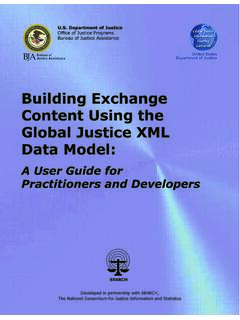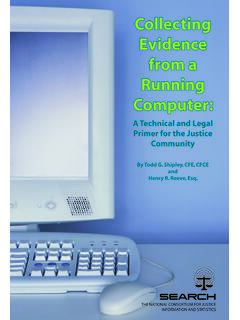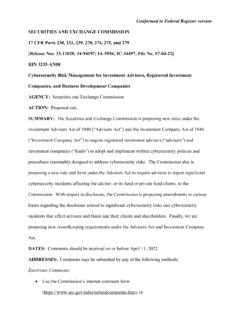Transcription of Governance Structures, Roles and Responsibilities - SEARCH
1 By Kelly J. HarrisSeptember 2000(Updated/Re-issued 2004)GovernanceStructures, Roles andResponsibilitiesPrepared forWho Decides? An Overview of How States Are Addressing Delegation of Authority and Decision-making in Managing Integrated Justice Information Systems:A Report on the Findings of A Survey of the Governance Structures of Statewide and State-levelIntegrated Justice Information Systems InitiativesBy theNational Criminal Justice AssociationFor Department of JusticeOffice of Justice ProgramsBureau of Justice AssistanceThis background report was prepared by SEARCH , The National Consortium for Justice Informa-tion and Statistics, Gerald E. Wethington, Chairman, and Ronald P.
2 Hawley, Executive J. Harris, Deputy Executive Director, Programs, wrote this report was produced under contract to the National Criminal Justice Association (NCJA),awarded to SEARCH Group Incorporated, 7311 Greenhaven Drive, Suite 145, Sacramento, Califor-nia of this document do not necessarily reflect the views or policies of the Bureau of JusticeAssistance or the Department of SEARCH , The National Consortium for Justice Information and Statistics, 2004. Thisversion has been updated from the original document, Structures, Roles and ResponsibilitiesContentsIntroduction .. 1 Integration: Defined for Justice Information Systems .. 1 State Responsibilities for Integrating Justice.
3 3 Forces Driving Justice System Integration ..4 Technology: The Enabler .. 4 Users Demand More .. 5 Public Expectations and Demands .. 6 Local Initiatives .. 6 National Initiatives .. 6 Why Governance Structures are Critical to Success .. 7 Structure .. 8 Formation .. 10 Membership .. 10 Roles and Responsibilities .. 12 Vision, Scope and Objectives .. 12 Operational Issues .. 13 Analyzing and Improving Business Processes .. 14 Technology and Standards .. 15 Funding Issues .. 16 Other Key Issues .. 17 Continuing Leadership .. 17 Conclusion .. 18 Governance Structures, Roles and ResponsibilitiesPage 1 IntroductionInformation technology and systems integration is not a phenomenonisolated to the justice community.
4 Indeed, all government has recog-nized the value and myriad benefits associated with informationsharing, including improved information quality, enhanceddecisionmaking, elimination of error-prone and redundant data entry,and timely access to information when it is needed for the justice community in particular, major initiatives at thefederal, state and local levels, combined with growing user needs andpublic demand for justice information, together with significantadvances in information and security technologies are driving effortsto exchange and integrate data among justice agencies, and with otheragencies critical to their mission. During this past decade, states acrossthe nation have established Governance structures to guide develop-ment of integrated justice information report provides detailed insight into the establishment of thesegoverning structures, their Responsibilities and Roles .
5 It examinesrecent developments in integrated justice planning and implementationacross the country, and how and why states have established commit-tees governing these : Defined for Justice InformationSystems1 Justice information systems integration is not a new idea agenciesthroughout the nation recognize the importance of integrating infor-mation systems to share critical data, documents, images and keytransactions. State and local jurisdictions are actively developingintegrated justice plans and systems improve the quality of information, and thereby thequality of decisions, by eliminating error prone redundant data addition, by sharing data between systems, integration typicallyimproves the timely access to information, a critical factor at manyjustice decision points ( , setting bail).
6 Moreover, integrationenables the sharing of crucial information without regard to time orspace; multiple users can access the same records simultaneously fromremote locations around the concept of integrated justice information systems, however,means different things to different people in different contexts. The1 This section was adapted from Organizing for Change, David J. Roberts, SEARCH , for the1999 Bureau of Justice Assistance, Department of Justice and SEARCH NationalConference on Integrated Justice Information Systems, February repor t providesdetailed insight into theestablishment Structures, their responsibilitiesand Roles . It examinesrecent developments inintegrated justiceplanning andimplementation acrossthe country, and howand why states haveestablished committeesgoverning 2 governance Structures, Roles and Responsibilitiesextent to which justice agencies across the country are integratingdepends on a number of variables, not the least of which is the defini-tion and scope of the individual integration project.
7 In many cases,integration takes the form of a single agency integrating its manyinformation systems, such as a state police agency integrating itscriminal records system with mugshot and fingerprint identificationdatabases. Significant improvements in efficiency and effectivenesscan be achieved when internal information systems communicatecritical data in a timely projects have taken a broader approach, integrating informationsystems between different agencies with different functions, but thatneed to share key pieces of data at critical points in the justice encompasses a variety of functions designed to enable thetimely and efficient sharing of information2 within and is important to recognize that building an integrated justice informa-tion system does not mean that all information between agencies isshared, without regard to the event.
8 The agencies involved or thesensitivity of the information available. Rather, it means sharingcritical information at key decision points throughout the arrest, for example, the arresting agency typically transmits certaininformation regarding the arrestee to the state criminal history recordsrepository ( , name, age, sex, race, driver s license number, elec-tronic image of the arrestee s fingerprints, etc.) to record the arresttransaction in the instant case, but also to verify the arrested person sidentity and determine whether they have a criminal history record inthe resident state, or in other jurisdictions around the addition, the agency will also query other state and national systemsto determine whether there are any outstanding warrants, detainers, orother holds on the arrestee.
9 For these transactions, the arresting agencydoes not need to share all information regarding the arrestee or theevent which led to the arrest, but only that information necessary forthe discrete transaction check for outstanding warrants or verifyidentity and report arrest transaction to the criminal history reposi-tory. 2 The term information is used here in its broadest sense to include data, images (photo,document and fingerprint), case records, calendar events, and electronic is impor tant torecognize that buildingan integrated justiceinformation systemdoes not mean that allinformation betweenagencies is shared,without regard to theevent, the agenciesinvolved or thesensitivity of theinformation , it meanssharing criticalinformation at keydecision pointsthroughout the Structures, Roles and ResponsibilitiesPage 3 Beyond improving the internal operations of justice agencies, integra-tion is more expansively viewed as enabling the sharing of criticalinformation between agencies.
10 Integration efforts are often referred toas horizontal ( , among different divisions of the same court system,or between the state police, court and correctional systems) or vertical( , from limited to general jurisdiction courts, from trial to appellateand state supreme courts, and from local agencies to state and na-tional/federal systems).3 Interagency integration, whether horizontal orvertical, generally refers to the ability to access and share criticalinformation at key decision points throughout the justice agencies throughout the nation already share considerableinformation. It is important to recognize that regional, statewide andnational systems currently exist to facilitate access to and sharing ofkey information among many of the actors in the justice enterprise.







